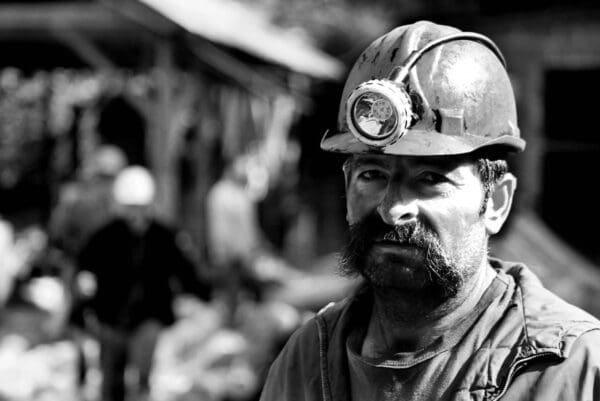01. Asbestos Risk for Mine Workers
How Are Mine Workers Exposed to Asbestos?
Mine workers may have experienced asbestos exposure through a variety of normal work activities. For decades, companies mined for asbestos in natural mineral deposits. Workers may have come into contact with asbestos in several ways during mining.
At-risk individuals include:
- Asbestos miners: For many years, raw asbestos was mined in North America. Mine workers may have been directly exposed to raw asbestos ore as it was mined and moved for processing. Asbestos mining can stir up the harmful fibers, and workers can inhale or ingest them when they are airborne.
- Miners of other materials: Asbestos deposits often occur near other minerals, like talc and vermiculite. Workers may have disturbed asbestos while mining for other minerals and separating the ore.
- Asbestos-product users: Miners may have also encountered asbestos in some of the equipment and products used in the industry. Asbestos was highly popular for its durability, fire resistance and heat-proofing. Until regulations were implemented in the 1980s, many companies added asbestos to their products.
Asbestos exposure may lead to diseases, such as lung cancer and malignant mesothelioma.
Miners operated a variety of asbestos-containing machinery. For instance, equipment manufacturers added it to products such as drills, gaskets, fireproof protective equipment and pipe insulation.
Today, mine workers may still use older equipment with asbestos parts. The history of asbestos and the lingering effects of its widespread use contributes to mine workers being considered a high-risk occupation for asbestos exposure.
The United States ended domestic asbestos mining in 2002. However, workers in talc mines remain in danger of encountering the mineral when extracting talc ore. This can lead talc workers to develop an asbestos illness. Consumers of these contaminated talc products also risk mesothelioma and other asbestos diseases.
Outside the United States, other countries are still mining the mineral. Asbestos miners in countries like Russia, China and Zimbabwe remain at high risk of asbestos exposure and related illness.
What Asbestos Products Put Mine Workers at Risk?
Mine workers have been at risk of asbestos exposure for decades, and the occupational exposure risk is ongoing. At least 34 states have naturally occurring asbestos deposits.
Asbestos companies put workers in danger of exposure through regular mining duties. In some cases, these workers experienced decades of asbestos exposure.
Exposure Risks for Asbestos Miners
Asbestos miners were directly exposed to the carcinogenic mineral. The mining process included breaking apart asbestos-containing ore with hammers and chisels, creating large amounts of asbestos dust in confined areas.
Without proper protective equipment, mine workers could easily inhale or ingest asbestos. The asbestos dust could also settle on their clothing, which mine workers may later carry home. This may put family members at risk of secondary exposure.
Asbestos Exposure Risks for Other Miners
The danger of asbestos exposure also exists during the mining of other mineral deposits. Excavating minerals loosens dust and other fibers, including asbestos. These ores, such as talc, vermiculite, copper and zinc, often occur near asbestos. Although asbestos itself is no longer mined in the United States, mining for other minerals near any natural asbestos deposits may still pose an exposure risk.
Asbestos companies also used the harmful mineral as an additive in products for years. Asbestos is affordable, durable and resistant to chemical corrosion and high temperatures. These properties made it an essential component for mining equipment, which undergoes rough conditions and high pressure.
Old equipment may still contain these parts. As a result, mine workers may be exposed to asbestos while operating or repairing asbestos-contaminated machinery.
Mine workers may have been exposed to asbestos products such as:
- Brakes
- Clutches
- Fireproof blankets
- Fireproofing gear
- Gaskets
- Insulation
- Transite panels (asbestos cement)
Asbestos product manufacturers and mine companies endangered mine workers’ health. If exposed, workers may later develop asbestos-related illnesses.
Despite asbestos regulations, mine workers are still at risk of exposure. Until a full asbestos ban is in place, old mining equipment and machinery may put mine workers at continued risk.
Common Places Asbestos Is Found in the Mining Industry
Mine workers may have experienced the highest risk of asbestos exposure while actively mining. Through regular mining operations, they may have disturbed asbestos.
The United States has natural asbestos deposits scattered throughout the country. Reports show there were around 65 total active asbestos mines in the U.S. at one time. Georgia, North Carolina and Wyoming were prominent asbestos mining states.
These deposits often occurred near enstatite, quartz and vermiculite. Libby, Montana, is home to a vermiculite mine, which W.R. Grace mined for years. While active, this mine was the top global producer of vermiculite. Libby vermiculite is now known to be contaminated with asbestos.
As a result of this exposure, Libby miners and residents have experienced lasting health issues. Talc mining presents similar concerns. Mining for any of these minerals puts workers at risk of asbestos exposure.
Asbestos mines that may have exposed mine workers include:
- A.E. Berrong property
- Alders mine
- American Asbestos Company mine
- Andrew Gennett property
- Asbestos Mining and Manufacturing Co. (Hollywood) mine
- Blue Rock mine
- Bok asbestos mine
- Brockton mine
- Bryson mine
- Burleson mine
- C-area quarry
- C.W. Allen prospect (Cane River mine)
- Casper Mountain asbestos deposits
- Chattooga River prospect
- Coldsides Mountain mine
- Commissioner Creek prospect
- Daniels quarry (Alberton deposit)
- Dillard prospect
- Eden quarry
- Fire King deposit
- Frank mine
- Gladwyne quarries
- H.V.M. Miller mine
- Henderson mine
- Hicks Asbestos mine
- Higdon mine
- Hinsdale mine
- Holden mine
- J.C. Woody mine
- Jenkins (Todd) mine
- Jennings No. 1 mine
- Jennings No. 2 mine
- Johns River mine
- Joseph L. Chambless property
- Kamiah asbestos deposits
- Karst asbestos mine
- Kilpatrick mine
- L.D. Garland property
- L.M. Arnold and E.R. Arnold properties
- Laurel Creek mine
- Lowell quarry
- Manus mine
- McCoy mine
- Miller mine
- Neikirk mine
- Newdale mine
- Nicholson estate mine
- Oakland mine
- Pelham asbestos quarry
- Peterman mine
- Reid mine
- Rockdale (Jacob Side’s) pits
- Round Mountain mine
- Sall Mountain Company property
- Sall Mountain mine
- Sam Grindstaff mine
- Sapphire mine
- Smedley’s asbestos mine
- Smith Creek deposit
- Thrash prospect
- Village Green (Hannum) asbestos pits
- Walnut Cove mine
Mine Workers and At-Risk Trades
The mining industry has diverse jobs and roles related to mine workers. Typical job responsibilities put them at risk for occupational asbestos exposure.
At-risk trades in the mining industry include:
- Asbestos miners
- Coal miners
- Crane operators
- Drilling engineer
- Engineering geologists
- Engineers
- Excavators
- Geologists
- Machine maintenance workers
- Machine operators
- Metallurgists
- Mining engineers
- Oil miners and workers
- Open cut examiners
- Petroleum engineers
- Pipefitters
- Riggers/doggers
The mining industry supplied asbestos manufacturing companies with the raw mineral. Workers at asbestos manufacturing plants were also at risk for exposure. Industrial workers, plant workers and boiler workers are just a few examples of other at-risk occupations.
Regulations in the late 1970s led to a decrease in asbestos consumption and production. While the United States no longer mines the mineral, other countries still mine and use asbestos. Imports may still contain asbestos, continuing to put workers in the mining industry at risk of exposure.
The United States Geological Survey (USGS) estimated the U.S. imported 100 tons of raw asbestos in 2021. The ongoing use of asbestos endangers workers and the general public.
02. Mesothelioma Risk for Mine Workers
Mesothelioma Risk for Mine Workers
Mining for asbestos and other minerals put mine workers, their families and residents near active mines at risk for exposure.
Activities such as drilling may release asbestos fibers from equipment or mineral deposits. Mine workers may have been exposed to asbestos during these activities. Scientists have linked specific diseases to asbestos, such as mesothelioma and asbestosis.
Mining activities may also contaminate the air, earth and groundwater. This may expose surrounding communities to ongoing asbestos contamination. In some cases, such as the mines in Libby, Montana, this exposure can last for decades.
Diseases such as asbestos cancers may take decades to develop. Generations of mine workers and residents may experience long-lasting health issues from asbestos.
Asbestos-contaminated mines put workers and nearby residents at risk of asbestos-related health issues. Miners and local communities may have elevated rates of asbestos-related illnesses.
03. Compensation for Mine Workers
Compensation for Victims of Occupational Asbestos Exposure
Some people who worked at or lived near mines have developed asbestos-related diseases. Many of these victims have filed lawsuits against asbestos companies for negligence. Mesothelioma lawyers have helped victims secure millions of dollars in settlements and verdicts.
For years, there were no asbestos regulations. However, many companies knew about the health risks of asbestos and continued to mine and use it. These companies can be held accountable for endangering workers and residents.
Asbestos companies put the health of mine workers, their families and other workers in the industry at risk. In many cases, they put entire communities and towns in danger. Experienced mesothelioma law firms have been holding asbestos companies accountable for years.
Another successful settlement involved a Spokane, Washington, trucker and laborer. This worker named the Grandview Mine in their asbestos case, among other exposure sources. This mine produced zinc and lead. The worker received a settlement of ~$1,036,897.
Mine workers may also qualify for other types of asbestos compensation as well. Mesothelioma lawyers can help victims understand if they are eligible for claims such as asbestos trust fund claims or workers’ compensation.
04. Asbestos Safety
Asbestos Safety for Mine Workers
In the 1980s, the United States began to implement federal asbestos laws and regulations. The Environmental Protection Agency (EPA) enforces many of these. The Occupational Safety and Health Administration (OSHA) enforces workplace standards.
A specific U.S. Department of Labor (DOL) division oversees the mining industry. The Mine Safety and Health Administration (MSHA) works to improve safety for miners. MSHA analyzes data for safety practices, such as asbestos handling and disposal.
As a result, the agency sometimes revises existing asbestos standards. In 2005, MSHA proposed a lower limit for asbestos exposure levels while mining. Strengthening asbestos restrictions may help protect mine workers from asbestos-related diseases.
While regulations and restrictions may help, mine workers and others will not be fully protected until the United States enacts a total ban of asbestos.




